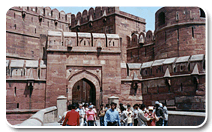AGRA FORT
One of the most impressive monuments in Agra, the Fort is situated on a bank of the River Yamuna. It was built during the years 1565 and 1574 by Mughal Emperor Akbar the Great. Later, his grandson, Emperor Shahjahan, added to the palaces and structures within the fort.
The Fort is situated at a short distance from the Taj Mahal, less than 2 kilometers away. Emperor Shahjahan was imprisoned in the Fort by his son Aurangzeb, when he took over the Mughal throne. Shahjahan spent the last years of his life in the Fort, where he is said to have spent his days looking at the Taj Mahal where his beloved consort Mumtaz Mahal was buried, from the balcony of the Mussaman Burj, a tower in the Fort. One can have a moving view of the Taj Mahal from Fort.
The Fort has a mighty wall made of red sandstone, which runs for 2½ kilometers around the perimeter of the fort. The main entrance to the Fort is through a grand gateway called Delhi Gate, which is decorated with inlay work in white marble. The Fort is partially occupied by the Indian Army and sections of the fort are restricted for tourists. There is another entrance through which tourists can enter, the Amar Singh Gate.
After entering the Fort, you will find yourself in the grand courtyard. The Diwan-i-Am or Hall of Public Audience and Diwan-i-Khas or Hall of Private Audience are located within the Fort and contain examples of exquisite Mughal carvings on their many pillars. There are grand palaces, such as the Khas Mahal and the Sheesh Mahal within the Fort. The rooms in the palaces were kept cool by an ingenious system of water channels that ran through all the rooms keeping them cool as the water evaporated. The high ceilings and marble latticed screens also provided natural cooling and blocked out the intense rays of the sun.
The mosques, Nagina Masjid and Mina Masjid, within the Agra Fort, were used by the royal family and the Mughal courtiers for prayer services. The Meena Bazaar was a small market where the ladies of the Royal Household could shop for perfumes, clothes, cosmetics, and jewelry. There are formal gardens with flowering plants and fruit trees in between the palaces within the Fort. You're sure to feel transported back to the Mughal era when you explore the Fort.



